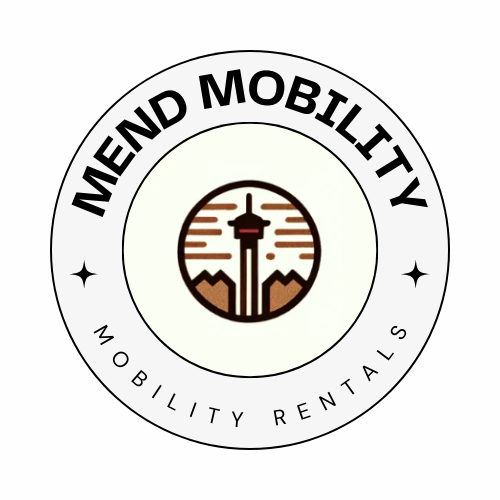If you've injured your leg, using a knee scooter can assist with mobility while avoiding putting weight on the injured leg.
Your healthcare team will provide specific instructions regarding weight-bearing limits for your injured leg, which should be closely followed.
Additionally, always adhere to the manufacturer's guidelines included with your knee scooter.
If you prefer video instructions use this video from Physical Therapy 101 as guide:
To adjust the fit of your knee scooter do this before the first use.
How to adjust the fit of your knee scooter
Adjusting the height of the knee rest pad
- Stand upright and, if necessary, use support for balance based on your weight-bearing ability.
- Bend your injured leg's knee at a 90-degree angle.
- Have someone measure the distance from the bottom of the bent knee to the floor.
- hen, adjust the knee rest to align with this measurement. You'll know it's at the correct height when your leg is resting on it at a 90-degree angle and your hips are level.
Adjusting the height of the handlebar
- Stand up straight.
- Position the handlebars to a comfortable level between your hips and waist. When standing upright and gripping the handlebars, ensure that you are not stooped over.
How to get on and off your knee scooter
Getting on your knee scooter
- 1. Position yourself alongside the knee scooter, placing your injured leg beside it.
- Ensure that the hand brakes are engaged.
- Grasp the handlebars firmly.
- Gently place your injured leg onto the knee rest, making sure to hold onto the handlebars beforehand.
- Keep your uninjured leg grounded next to the knee scooter, ensuring stability and balance before walking or moving.
Getting off your knee scooter
- Press the hand brakes, once the scooter has stopped moving.
- Keep your hands on the handlebars
- Step off the knee scooter.
How to walk with your knee scooter
- 1. Place your uninjured leg on the ground beside the knee scooter to ensure stability.
- Release the hand brakes.
- Begin moving forward by pushing with your uninjured leg in small increments.
- Use the hand brakes to regulate speed and slow down when necessary.
- To stop, gently press down on the ground with your uninjured leg while applying the hand brakes lightlyKeep your non-injured leg on the ground next to the knee scooter. Make sure that you are stable and balanced.
How to turn your knee scooter
- Before you turn, slow down using your non-injured foot and the hand brakes.
- Turn the handlebars to guide the wheels in the direction you would like to go. If the turn is tight, you might need to do a 3-point turn (scooting backward and forward to make the turn). With practice, this should become more natural.
How to go up and down curbs
Going up curbs (ascending)
- Bring the front wheel of your knee scooter to the curb.
- Lean forward over the handlebars as you slowly lift the front 2 wheels onto the curb.
- Move the knee scooter forward and apply the brakes to avoid rolling backward and to keep the knee scooter in place.
- Put your non-injured foot onto the curb.
- Release the brakes and slowly roll the knee scooter forward to bring the back wheels up and onto the curb.
Going down curbs (descending)
- Get close to the edge of the curb.
- Squeeze the brakes.
- Lean slightly backward as you slowly bring the front wheels off the curb.
- Step down with your non-injured foot.
- Slowly roll forward to bring the back wheels down off the curb.
Safety tips
- Take some time to familiarize yourself with the mobility device.
- Go slow. Do not scoot at high speeds.
- Keep both of your hands on the handlebars at all times.
- Always slow down before making a turn. Use your brakes and non-injured foot to slow yourself down.
- When you are scooting downhill, keep your speed slow and controlled. Use both your handbrakes and your non-injured foot to control your speed. Take small, quick steps with your non-injured leg.
- Always keep your body balanced on your knee scooter.
- If you need to reach out for something, park the knee scooter as close as possible to where you need to reach. Always put on the brakes before reaching. Avoid reaching for things on the floor while you are on your knee scooter.
- Think about getting a basket to attach to your knee scooter if you think that you will need to carry things.
- If possible, avoid uneven ground and curbs.
- Do not use your knee scooter on stairs or steps.
- Do not use a knee scooter if you have issues with balance, coordination, or vision, or if your non-injured leg is not strong and healthy.
- Avoid walking pets when you're on your knee scooter.
If in doubt consult the factory manual of the knee scooter device or reach out to your doctor or physiotherapist.

